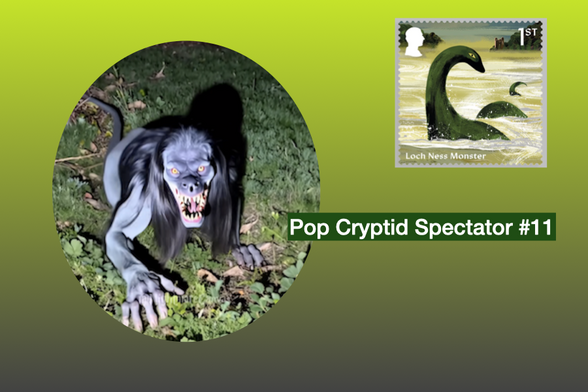This was made for kids right xD hahah #nightmarefuel
Recent searches
Search options
#nightmarefuel
Pop Cryptid Spectator 11
Welcome to the Pop Cryptid Spectator, the newsletter that goes to 11. So far. I am never short of examples to share that illustrate the Pop Cryptid model – where cryptids have moved into the mainstream for several social and economic uses but away from the zoological idea of discovery of new animals.
In this edition:
- Digital hoaxes flooding social media
- Questioning the assumptions we make about supernatural cryptids
- Cryptid media – The Sasqualogist
- Blurry feral Florida cat causes a stir
- Loch Ness Quest 3
- Royal Mail mythical stamps
- Cryptids are “hot”, particularly in WV
Digital hoaxes flooding social media
If you can create digitally enhanced or AI-manufactured videos, you are in business these days. I don’t know how to do this but I suspect all it takes is some tech know-how, some raw material to start with, and a creative imagination. Digitally manufactured creature shorts make up about half of a TikTok #cryptids feed. Shorts are easily shared and also show up in Facebook feeds and on YouTube.
There are two general categories of these videos. First is the obvious artistic, fun hoax. Only the pathologically gullible viewers will think these depict real creatures (that’s usually around 20% but that depends, read on). The second kind is content that seems fake in the context of all the other fakes, but it’s not obvious because it looks like the typical cryptid video – blurry, too far away, and leaving room to imagine what you are seeing. Or, it shows just enough of a strange creature to convince you that it’s a legit but weird.
The fun hoax
The majority of “cryptid” short videos are obviously fictional. Frightening and bizarre creatures are shown oddly well lit in a cave or underground workings, or in a house or backyard setting accompanied by creepy music. The creatures may not be immediately identifiable because they are derived from exaggerated or extra features of real animals or people – giant size and terrifying teeth are typical examples. Made by accounts with names like “NightmareCanvas”, “CreatureCapture” or “CursedContent”, they carry hashtags like #cryptidtiktok and #nightmarefuel. These are pretty fun. Assuming the viewer doesn’t take this seriously, these function as an entertaining creepy short. Mostly, the commenters play along with silly jokes about it. They get it.
The questionable reality-adjacent vids
Videos that look more possibly real might grab a lot more people’s attention outside of the #nightmarefuel crowd. Many of these videos appear to come from Central and South America and feature what is said to depict a local folklore creature come to life. You can find the most popular of these videos being promoted by paranormal sites, like Coast to Coast AM. They often write up a summary featuring the location and background of the stated creatures which will reinforce and share the legend to a wider audience. That would be fine if the content wasn’t explicitly linked to a hoaxed video.
The latest of these is a short video of what is called a Chaneque said to have been found in Veracruz, Mexico. A translated version from a local TV network says the following:
The state of Veracruz is one of the regions with the most legends and myths about strangers in the country, and the appearance of a Chaneque in 2025 has made it clear.
The images show a humanoid figure with large eyes, wrinkled skin and pointed ears that emits indescribable sounds with a hoarse voice while trapped in a rocky area.
However, this clip quickly went viral on social media, where users questioned whether or not it was a {chaneque}, as this could have been made with artificial intelligence.
https://www.youtube.com/watch?v=JFc7cmHSjtM
So, this was presented in a sober manner. I am, however, losing valuable details because of the language barrier. I can’t tell if this is like the clickbait we get in the US on certain media sites (particularly FM radio station websites) that are designed for attention and ad revenue, not as news.
The background of the chaneque and other examples like these have a strong supernatural connotation. Also in this past month, Coast to Coast featured a story and video of a “demonic humanoid” in Argentina. Any moderately critical thinking will flag this as fake right off.
These shorts almost never have appropriate details for investigation. That’s not their purpose. They are meant to be consumed and shared, not researched. I cannot tell how they are perceived in their local context and I would like to know. Is it like our reaction to the Bat Boy cover of the Weekly World News tabloids?
Experiencing the presence of folklore creatures is normal in other cultures. However, inevitably, some English-speaking commenters are either childishly gullible (or are children, which is a reasonable possibility) or they are playing along with the alternative reality where it’s fun to believe these creatures exist.
The popularity of these creature shorts, and the willingness of paranormal sites to feature them as potential cryptids lend support to the Pop Cryptid model, which asserts that we really aren’t interested in the zoology anymore, but in entertainment.
Questioning the assumptions we make about supernatural cryptids
Let’s explore a bit deeper into the concept that other cultures have different views on supernatural entities.
This week, a paper by Roy Ellen titled Visualizing Spirit Entities: Naming, Classification, and
Pictorial Representation of Pseudo-Natural Kinds in Nuaulu Cosmography, published in Folklore caught my attention due to its reference to the overlap between spirit entities and animals. The Nuaulu people are in Seram, Indonesia. The author notes that while studying Nuaulu ethnozoology, it was “difficult to enquire about knowledge of animal forms without yielding related data on spirits, or to enquire about spirits without yielding data on animals.”
This topic has always interested me, but it fails to generate enough thought in the sci-cryptid researcher community. Cultures very different from our embedded culture interpret spirits and the supernatural very differently from our frame. There is a complication that arises via the translation since western audiences aren’t taking that difference into account.
Ellen writes that some of the native words can refer simultaneously to the animal and the spirit; spirits can inhabit animals and influence their behavior; animals may originate from spirits. The overlapping and multi-dimensionality is complex.
This is not uncommon. From the previous story about the chaneque, we are required to consider how accounts reporting encountering folklore creatures are received in the community. For comparison, there are certainly populations in the US where outright belief in ghosts, demons, angels and various other creatures are mainstream and not unusual. Context matters.
Cryptozoology researchers who claim a scientific framing in research will strip out the non-natural characteristics in the reported descriptions and assume a zoological animal is hiding in there somewhere. Such a process is prone to massive errors. They simply aren’t seeing important aspects of the bigger picture – that the “animal” can’t be discovered at all because it’s a spirit.
The most obvious example of use of native legends in this way is for Bigfoot itself. You can’t capture Bigfoot because he’s not an ape. He’s non-corporeal. Many cryptids suddenly seem to acquire a history related to native legends in order to boost its age and credibility. How do cryptozoologists know if the legend is realistically connected to the modern stories of encounters? They don’t. They assume it, giving the cryptid a much more colorful and credible history but misleading themselves. Or, has the inclusion of native legends greased the wheels for cryptids to become predominately non-zoological? I think that might have played a part, as well as the current practice of people exploring alternative spiritualities.
The Ellen paper can be found here.
Cryptid media – The Sasqualogist
The Sasqualogist is an independent drama/comedy staring Joseph Granda as a Bigfoot researcher and seeker. Website: https://www.thesasqualogist.com/
https://www.youtube.com/watch?v=04-pMjZoaBo
The new film, out soon, has as one of its themes, two people with different views on the nature of Bigfoot. Is it an ape to be studied and maybe captured? Or is it an inter-dimensional being flitting in and out of our world? That’s a core item of the pop cryptid theme right there – the changing nature of cryptids. Old orthodox views using the fringe science framing, is put up against the wide-open anything-goes belief. The writer/director of the film refers to these two groups as the “Apers” and the “Woos”. He further explains why he tackled this topic:
Director Statement: Why Bigfoot?
At the tender age of 10, my father walked away from our home, vanishing from my life forever. Years later, his lifeless body was discovered near the Sequoia National Forest. The absence of a father casts a haunting shadow over a young man, leaving behind a lingering void that never truly dissipates. It took me years to unravel the roots of my obsession with Bigfoot, tracing it back to the loss of my father amidst the wilderness of abandonment.
From childhood memories of the Six Million Dollar Man grappling with Sasquatch to my adulthood compulsion to collect Bigfoot memorabilia, each encounter served as a silent yearning for a surrogate guide through life’s dense forests. “THE SASQUALOGIST” is not merely a movie; it’s a journey into the depths of human longing, a quest for connection with something larger than ourselves.
Note that we have the 1970s depiction of cryptids, cryptid merch, symbolism regarding keeping the mystery alive, and shades of Missing 411 belief where people attempt to reframe an accident into something huge and mysterious. That’s a lot of interesting bits and pieces packed into a movie. The film was shown at film festivals last year but I can’t find it streaming yet. The website says it’s coming soon. Watch for it.
Blurry Florida feral cat causes a stir
On a regular basis, the news media will pick up on a Facebook post from an organization or person who has captured a strange thing on a game camera that is not readily identifiable. And the internet then embarks on what I call “mass opinionation” where everyone adds their uninformed two cents about what it is. Most often the comments are jokey, but many people play pretend wildlife experts. Frequently, when the animal has glowing eyes resulting from the image capture, some wild and crazy opinions are proposed. This happened last week when a (very) cat like creature was caught on the camera roll on public lands by the South Florida Wildlands Association. They posted the pic to Facebook and the story got picked up by the Miami Herald.
“Looks a little bit wrong and a little bit right for a number of different species,” the foundation wrote in the post. “Anyone want to venture a guess?” The post has racked up hundreds of reactions and comments, including references to legendary shape-shifters and the chupacabra, a vampire-like beast of legends said to have “glowing red eyes.”
Ugh. I’d bet on a feral house cat or some imported, escaped non-native cat. There is no need to invoke extreme explanations. I’m flummoxed by why a legitimate organization would do this kind of stunt other than it gets a ton of attention. I suppose it’s interesting data to find a feral cat in this area. But, in the end, it does promote misinformation.
Game cameras that take images in the dark will blur and distort the subject because it’s moving and the image capture speed is too slow. Instead of taking account of how that will happen, people will take the image literally and wildly speculate on what the blurry creature is. There is nothing confusing about the photo, just about the intent of its promotion.
Loch Ness Quest 3
The collective Loch Ness monster search, The Quest, is returning for the third year. The Loch Ness Centre has updated their Remotely Operated Vehicles (ROVs) to search the waters and are adding baited camera traps. The 4 day event in May brings people from all over the world to the Loch to participate in the search. Every year, someone finds some tantalizing bit that the media can chew on but the monster is myth, so it’s never going to fully appear. But the myth goes on…
Royal Mail mythical stamps
The British Royal Mail is releasing a set of eight new stamps from different regions across the UK that show the “rich mythological heritage”. Nessie is included along with Black Shuck (my favorite), selkies, Cornish piskies, (Welsh) Blodeuwedd, folklore figure Fionn mac Cumhaill (Finn McCool), the Grindylow and Beowulf & Grendel. The artwork is fabulous.
I wonder if they will get complaints about lumping in the “real” Nessie with the “myths”.
Cryptids are “hot”, particularly in WV
Linking back to PCS 9, regarding a new zine for West Virginia about folklore traditions, this article about the projects shows just how popular cryptids are, noticed by people who didn’t know what they were at first. Then they saw the public reaction. Now they are aware. Lydia Warren, the director of the Folklife center in West Virginia remarked at how impressed they were with the turnout for the Veggie Man festival in 2024:
While we were at Veggie Man Day, they had booked all these amazing vendors, all these really cool West Virginia artists to do cryptid and other paranormal themed artwork. So, there were vendors who had dolls made out of felt, that were little cryptid dolls. There were people doing amazing drawings of Mothman, and, obviously, Veggie Man because it was Veggie Man Day.
In discussion with the founding director, they realized “this cryptid thing is really, this is hot. This is a big deal.” And they decided to pursue the new publication. The pop cryptid model in action!
When asked why cryptids are big, she notes the interest in all things Appalachia which follows from the cryptid depictions in the game Fallout. Along with media, particularly the Mountain Monsters TV show, people have built connections around folklore creatures. She also comments that cryptids are a safe and fun topic in these divided times. They are copyright free, fun, and become cultural touchstones. Gee, it seems like someone has been reading my Pop Goes the Cryptid page!
Veggie Man is a lower-tier cryptid, derived from one story in the 1960s in Marion County where a man of good reputation saw an injured “human” that “looked very vegetable-ish”. The story, associated with UFOs, was promoted by renowned legend promoter Gray Barker. The Veggie Man Day festival takes place in July at the Folklife Center in Fairmont, WV.
Thanks for reading! Send comments, questions, or suggestions to sharon(at)sharonahill.com. If you want to send some cryptid plushies or other merch, or books to review, email for my physical mailing address.
For more, click on Pop goes the Cryptid landing page. Make sure you subscribe to all the posts – it’s always free and I don’t send annoying spam.
Pop Cryptid Spectator is also available on Substack. Please share this with cryptid fans you know!
Pop Cryptid Spectator Pop Cryptid Spectator 10Pop Cryptid Spectator 9
Pop Cryptid Spectator 8
Pop Cryptid Spectator 7
Pop Cryptid Spectator 6
Pop Cryptid Spectator 5
Pop Cryptid Spectator 4
Pop Cryptid Spectator 3
Pop Cryptid Spectator 2
Pop Cryptid Spectator 1
#1 #chupacabra #cryptid #Cryptozoology #deathOfAUnicorn #popCryptid #reddit #rollerCoaster #scientific #seaSerpents #Skinwalker #Wendigo
Just released on our YouTube channel!!
The Midnight Toe A Chilling Encounter with the Unknown. #HorrorStory #GhostStory #Supernatural #Paranormal #ScaryStories #CreepyTales #HauntedRoom #MysteriousEncounters #NightmareFuel #MidnightHorror #HorrorNarration #ClassicHorror #UnsolvedMystery
was just talking with someone who had (thankfully) never heard of mouth pipetting and then found this article and the accompanying pictures are *HORRIFYING*!!
#science #lab #mouthpipette #nightmarefuel
https://www.discovermagazine.com/the-sciences/suck-it-the-ins-and-outs-of-mouth-pipetting
If there was one meme or gif you would bury at the bottom of the sea, what would it be?
Mine is the bald guy at the rave with his mouth open and crazy eyes. He looks like Rick Scott and Rev Henry Cane's long lost triplet. #NightmareFuel
No thank you, Temu, I won’t be hanging this on my Christmas tree.
But kudos for making Elmo look like a girl.
This just walked in my back yard as I was taking the dogs out. Had my phone and was trying to take pictures of the moon.
#Alien #Grey #AlienGrey #Communion #CloseEncounter #CloseEncounterOfTheThirdKind #Disturbing #NightmareFuel #Photography #PhotographersOfMastodon
@WarnerCrocker Imagine a whole fleet of these AI warplanes, and Donald Trump in charge of it all. #NightmareFuel



